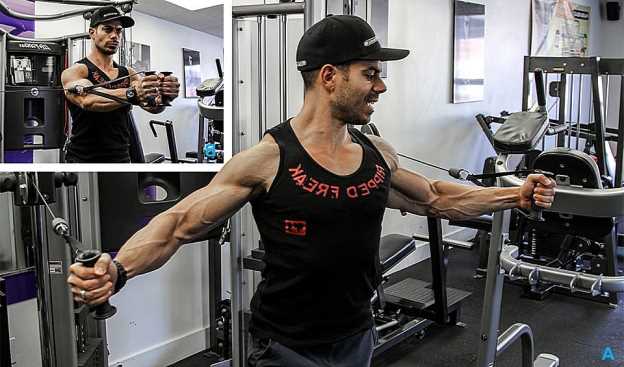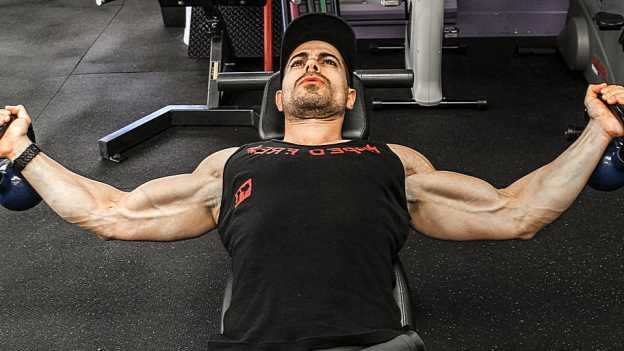 Are you ready to transform your chest and go from flab to fab? Building strong, sculpted pectoral muscles can not only enhance your physical appearance but also boost your overall confidence and strength. In this guide, we’ll dive into effective chest exercises, pectoral development strategies, and chest transformation tips to help you achieve your goals. Let’s get started on this exciting journey!
Are you ready to transform your chest and go from flab to fab? Building strong, sculpted pectoral muscles can not only enhance your physical appearance but also boost your overall confidence and strength. In this guide, we’ll dive into effective chest exercises, pectoral development strategies, and chest transformation tips to help you achieve your goals. Let’s get started on this exciting journey!
Imagine having a well-defined and toned chest that turns heads wherever you go. A strong and sculpted chest not only adds a touch of confidence to your posture but also contributes to your overall physical fitness. The transformation process is all about taking consistent steps towards your goals and embracing the journey. It’s time to unleash the power of your pectorals and transform your chest into a symbol of strength and vitality.
But before we dive into the specifics, let’s take a moment to understand the pectoral muscles, their anatomy, and their functions. This knowledge will empower you to make informed choices and tailor your workout plan to maximize your results. Additionally, we’ll debunk some common misconceptions about chest training that might be holding you back from achieving your desired chest transformation.
Understanding the Pectoral Muscles
Your pectoral muscles, often referred to as pecs, are a group of muscles located in the chest region. These muscles play a crucial role in various upper body movements, such as pushing, pulling, and lifting. The primary function of the pectorals is to bring your arms across the front of your body, allowing you to perform exercises like bench presses, push-ups, and dumbbell flies.
It’s important to note that many people believe that chest exercises are only for men. However, this is a common misconception. Both men and women can benefit from training their pectoral muscles. In fact, a well-developed chest can enhance your overall physique, improve posture, and contribute to a balanced and proportionate body shape. So, let go of any preconceived notions and embrace the power of chest workouts to achieve your goals.
Setting Goals and Creating a Plan
Before embarking on your chest transformation journey, it’s essential to set clear goals that align with your aspirations. Take some time to identify what you want to achieve with your chest development. Whether it’s building strength, increasing muscle mass, or achieving a more defined look, having specific goals will help you stay focused and motivated.
Once you’ve established your goals, it’s time to assess your current chest strength and size. This will serve as a baseline to track your progress and determine the areas you need to focus on. Consider taking measurements, performing strength tests, and even taking before-and-after photos to visually track your transformation.
With your goals and baseline assessment in mind, it’s time to design a personalized workout plan. Tailor your routine to target the pectoral muscles effectively while considering your current fitness level. Incorporate a combination of compound exercises, such as barbell bench presses and push-ups, along with isolation exercises like dumbbell flies and cable crossovers. Aim for a well-rounded approach that addresses different areas of your chest for optimal results.
Proper Nutrition for Chest Development
Achieving a chest transformation goes beyond just working out. Proper nutrition plays a crucial role in supporting muscle growth and development. Make sure to maintain a balanced diet that includes a mix of lean proteins, complex carbohydrates, and healthy fats.
Protein, in particular, is vital for muscle growth. Include sources like lean meats, fish, eggs, dairy, and plant-based proteins in your meals. Additionally, complex carbohydrates like whole grains, fruits, and vegetables provide the energy required for intense workouts. Don’t forget to incorporate healthy fats from sources like nuts, seeds, avocados, and olive oil, as they support hormone production and aid in muscle recovery.
Furthermore, pay attention to your pre- and post-workout nutrition. Fuel your body with a light meal or snack containing carbohydrates and protein before your workout. Afterward, replenish your muscles with a post-workout meal or protein shake within an hour of completing your session. This will help optimize muscle recovery and growth.

How to Build Your Pectorals: Effective Exercises
Now, let’s dive into the exciting part: the effective exercises that will help you sculpt your pectoral muscles. There are various exercises that target different areas of the chest, so it’s important to incorporate a variety into your routine.
Start with compound exercises like barbell bench presses, which engage multiple muscle groups and provide a solid foundation for chest development. Dumbbell presses and push-ups are also excellent choices for overall chest engagement. To target specific areas, include exercises like dumbbell flies for the outer chest and cable crossovers for inner chest development. Remember to focus on proper form and technique to maximize the effectiveness of each exercise.
Vary your routine by incorporating incline and decline movements, which target the upper and lower chest respectively. This will help create a balanced and well-defined chest. Don’t forget to gradually increase the weights and challenge yourself over time to promote progressive overload and continuous growth.
Progressive Overload and Workout Progression
To truly transform your chest, it’s important to understand the principle of progressive overload. This principle involves gradually increasing the intensity and difficulty of your workouts over time to continue challenging your muscles and promoting growth.
There are several strategies you can employ to incorporate progressive overload into your chest training. You can increase the weight you lift, perform additional repetitions, decrease rest time between sets, or try more advanced variations of exercises. By consistently pushing your limits and adapting your workouts, you’ll stimulate your pectoral muscles to grow stronger and more defined.
Tracking your progress is crucial to ensure you’re making steady gains. Keep a workout journal or use a fitness app to record your exercises, weights, sets, and repetitions. This will help you monitor your progress, identify patterns, and make necessary adjustments to your workout plan. Remember, consistency is key in achieving a remarkable chest transformation.
Avoiding Common Mistakes
When it comes to chest training, it’s important to avoid common mistakes that can hinder your progress or lead to injury. One common mistake is selecting the wrong exercises that don’t effectively target the chest muscles. Make sure to focus on exercises that specifically engage the pectorals to maximize your results.
Another mistake to avoid is overtraining. While it’s important to challenge yourself, giving your muscles time to rest and recover is equally crucial. Overtraining can lead to fatigue, lack of progress, and even injury. Listen to your body and schedule regular rest days into your workout routine. Additionally, prioritize proper form and technique during exercises to prevent injuries and ensure optimal muscle activation.
Supplementing Your Chest Training
While a well-balanced diet should be the foundation of your chest transformation, certain muscle-building supplements can complement your efforts. Before considering any supplements, it’s important to consult with a healthcare professional or a registered dietitian to ensure they align with your goals and are safe for you to use.
Supplements like protein powder, creatine, and branched-chain amino acids (BCAAs) are commonly used to support muscle growth and recovery. These supplements can provide an extra boost of nutrients and aid in optimizing your chest development. However, remember that supplements are not a substitute for a nutritious diet and consistent training.
Rest and Recovery
Rest and recovery are often overlooked but essential aspects of chest training. It’s during rest that your muscles repair and grow stronger. Make sure to incorporate rest days into your workout schedule to give your chest muscles the time they need to recover and adapt to the stress of your training.
In addition to rest days, prioritize quality sleep. During sleep, your body releases growth hormones that aid in muscle recovery and development. Aim for 7-9 hours of uninterrupted sleep each night to maximize the benefits of your chest transformation efforts.
Implementing recovery techniques such as stretching, foam rolling, and gentle mobility exercises can also help alleviate muscle soreness, improve flexibility, and enhance blood circulation. Don’t underestimate the power of rest and recovery in achieving optimal results.

Staying Motivated and Overcoming Plateaus
Throughout your chest transformation journey, it’s normal to face challenges and encounter training plateaus. The key is to stay motivated and find strategies to overcome these obstacles.
To stay motivated, set short-term milestones and reward yourself when you achieve them. Celebrate your progress along the way, whether it’s hitting a weightlifting milestone or noticing improvements in the mirror. Surround yourself with a supportive network of friends, family, or workout buddies who can provide encouragement and accountability.
When you hit a plateau, it’s time to shake things up. Modify your workout routine by trying new exercises, changing the order of your exercises, or incorporating different training techniques like supersets or drop sets. Additionally, consider seeking guidance from a fitness professional who can provide expert advice and help you break through your plateau.
Tracking and Evaluating Results
Tracking and evaluating your results are crucial to ensure you’re making progress and making necessary adjustments to your chest transformation plan. Take measurements regularly to monitor changes in your chest size, strength, and overall physique.
Evaluate your strength gains by periodically testing your one-repetition maximum (1RM) on exercises like the bench press or dumbbell press. By comparing your 1RM over time, you can gauge the improvements in your chest strength.
Based on your tracking and evaluation, adjust your workout plan as needed. If you’re not seeing the desired progress, consider tweaking your exercises, sets, repetitions, or weight progression to continue challenging your pectoral muscles.
Conclusion
Congratulations on taking the first step toward transforming your chest from flab to fab! Building strong and sculpted pectoral muscles is a rewarding journey that requires dedication, consistency, and a well-designed plan. By understanding the anatomy of your chest, setting clear goals, following effective exercises, and prioritizing rest and recovery, you’re well on your way to achieving an impressive chest transformation.
Remember to stay positive, stay committed, and embrace the process. Your hard work will pay off, and soon you’ll be flaunting a chest that turns heads and boosts your confidence. So, let’s get started on this exciting adventure and sculpt those pectorals to perfection!
Leave a Reply